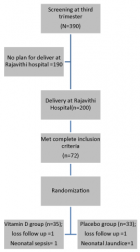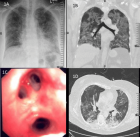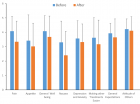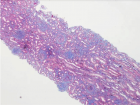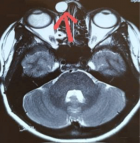Table of Contents
Identifying mothers experiencing emotional distress in the neonatal intensive care unit. Application of PPTSD questionnaire in a Greek NICU population
Published on: 7th October, 2022
The birth of a high-risk infant such as an extremely premature infant can represent an important traumatic experience for mothers. Perinatal Post Traumatic Stress Disorder Questionnaire (PPTSDQ) explores retrospectively maternal post-traumatic stress reaction. This shelf-rating questionnaire explores the potential for experiencing posttraumatic symptoms related to childbirth and the ensuing post-natal period. The PTSD questionnaire was originally developed by DeMier and Hynan and their colleagues at the University of Wisconsin and has been widely used in research and in clinical practice for identifying mothers experiencing significant emotional distress during the post-natal period, so they may be referred for mental health services. The present study aims to introduce this tool in perinatal settings as an early intervention. It has been widely used with other measures of post-traumatic stress and depression, such as the Openness Scale from the NEO-PR, the self-report measure of depression BDI-II, the IES (Impact Event Scale) and the EPDS (Edinburgh Postnatal Depression Scale). Although already a useful clinical instrument the current study used the revised version. This modification refines the response options from dichotomous choices to a Likert scale format by Callahan Borja and Hynan. Numerous qualitative and quantitative studies state that premature delivery is a highly stressful event and document the full range of post-traumatic sequelae, such as intrusive recollections, behavioral avoidance, and hyperarousal, as well as attachment difficulties following childbirth. Furthermore, the severity of neonatal complications and gestational age have been found to be predictive of PTSD symptomatology in parents as measured by the PPQ. For this reason, the current study aims to give increased focus to mothers having a premature birth and often expecting their children to die. The sample comprises 25 mothers of prematurely born infants hospitalized in the NICU and 25 mothers of full-term infants born in the maternity ward of the same Greek hospital who responded to the Perinatal PTSD Questionnaire and equally the PERI a postnatal complication rating inventory and the clinical interview for parents CLIP.Mothers of high-risk infants present post-traumatic stress reactions related to prematurity. The Perinatal PTSD Questionnaire identifies postnatal maternal distress but should not substitute a clinical interview, yet findings indicate that equally identifies pre-existing distress symptoms associated with maternal personality traits that emerged with the traumatic event of the unexpected birth.Due to the consistency of the population of the experimental group, who come mostly from the provinces, the possibility of a follow- up of the cases is quite limited.
Effectiveness of structured teaching programme on knowledge regarding management of extravasation of chemotherapeutic drugs
Published on: 13th September, 2022
Background: More than 1 million intravenous chemotherapy infusions are given worldwide each day which leads to extravasation. Health professionals must know the drugs that cause tissue injury and take the necessary measures to prevent extravasation.Objectives: The study aimed to assess the knowledge regarding the management of extravasation of chemotherapeutic drugs before and after the implementation of a structured teaching program among staff nurses.Method: The pre-experimental group pre-test and post-test designs were adopted for the study. The convenience sampling technique was used to obtain 30 staff nurses of Ramaiah Medical College Hospital, India. Both Pre-test and Post-test were performed using the same structured knowledge questionnaire followed by 45 minutes of the structured teaching program. Data were processed through Statistical Package for Social Sciences version 20 and analyzed using descriptive and inferential statistics.Results: More than half of the subjects were female (66.7%) and 36.7% of the subject had more than 10 years of professional experience. Most of the subjects (70%) had inadequate knowledge during the pretest. The mean knowledge score was 15.33 ± 4.003 and 24.67 ± 5.384 in pre-test and post-test respectively. There was a significant difference in pre-test and post-test knowledge scores regarding the management of extravasation of chemotherapeutic drugs. Conclusion: The Study concluded that the structured teaching program was significantly effective in improving the knowledge regarding the management of extravasation of chemotherapeutic drugs among nurses.
Predicting physical symptoms through expressions of loneliness and anxiety in individuals utilizing social media during SARS-CoV-2
Published on: 25th April, 2022
The effect of the novel coronavirus (SARS-CoV-2) pandemic has produced significant health concerns negatively impacting individuals. As the ongoing and constantly changing nature of SARS-CoV-2 continues, the unique characteristics of this pandemic trend toward anxiety and loneliness as significant behavioral health outcomes. Furthermore, the SARS-CoV-2 pandemic has significantly impacted the utilization of social media platforms such as Twitter. Utilizing over 1.6 million tweets from approximately 988,760 Twitter users geolocated in Washington state from the University of Pennsylvania’s publicly available Twitter database (from March 2020 to March 2021), this study evaluated the impact of SARS-CoV-2 by using expressions of loneliness and anxiety to predict mental and physical symptoms. Bivariate correlations revealed expressions of loneliness were correlated to trouble breathing while expressions of anxiety were correlated to skin lesions, body aches, flu-like, seasonal cold, trouble breathing, nausea or diarrhea, fever, chills, and cough. Multiple multivariate linear regressions were completed, and a significant regression equation was found in predicting trouble breathing symptoms on expressions of loneliness and anxiety, however, the proportion of variance was 8% of the observed variation in the model. Further implications revealed the importance of understanding mental and physical well-being during a public health crisis as well as the use of social media platforms as primary and supplementary stimuli.
Stage and symptoms of bipolar disorders
Published on: 6th April, 2022
Bipolar disorder (formerly called manic-depressive illness or manic depression) is a mental disorder that causes unusual shifts in mood, energy, activity levels, concentration, and the ability to carry out day-to-day tasks. During mood swings, there may be features of psychosis (delusions and hallucinations) that are mood-congruent. Although psychotic symptoms are seen only in a minority of patients, they explain the early terminology of manic–depressive psychosis. Stage 1a is defined as mild or non-specific symptoms of mood disorder and intervened as formal mental health literacy; family psychoeducation; substance abuse reduction; cognitive behavioral therapy. Euphoric means the experience of pleasure or excitement and intense feelings of well-being and happiness. Certain natural rewards and social activities, such as aerobic exercise, laughter, listening to or making music, and dancing, can induce a state of euphoria. Racing thoughts are consistent, persistent, often intrusive thoughts that come in rapid succession. There is a direct link between depression and anxiety and racing thoughts. Whereas jumping from topic to topic as in the flight of ideas can be observed by others, ascertainment of racing thoughts requires asking the child whether his or her thoughts seem to be going too fast.
Prevalence of and institutional factors associated with depression among undergraduate students at Gulu University
Published on: 11th March, 2022
OCLC Number/Unique Identifier: Academic performance; Depression; Undergraduate st
Background: Many institutional factors predispose University students to mental health issues, including depression. However, with no central database for depression in Uganda, literature on depression and associated institutional factors among undergraduate students is scarce. This study examined the prevalence of and institutional factors associated with depression among undergraduate students at Gulu University.Methods: This was a cross-sectional survey among 452 undergraduate students at Gulu University in the academic year 2018/2019 in February and March 2019. A stratified simple random sampling was used to identify the participants. A self-administered questionnaire was used to collect data. Descriptive statistics, including mean and frequency, were used. We conducted a bivariate analysis to determine the association between variables employing Pearson’s chi-square test or Fischer’s exact test. We conducted a multivariate analysis with factors that had significant P-values of less than 0.05.Results: The average age of the respondents was 22.4 (SD - 2.4), more than half (53.1%) were male and 38.50% were in the second year. The results show that 31.19% reported depression. After controlling for age and sex, the results showed that there was a statistically significant correlation between depression and faculty (aOR - 1.15), year of study (aOR - 0.77), happiness with the course (aOR - 0-0.49), satisfaction with academic performance (aOR - 0.45), and satisfaction with academic quality (aOR - 0.61). The results indicated that the predictors of depression among undergraduate students were faculty, year of study, satisfaction with academic performance, and satisfaction with academic quality. Conclusion: A substantial proportion of Gulu University undergraduate students reported high levels of depression. The results, therefore, showed that depression in undergraduate students is an identifiable disorder that needs diagnosis, prevention, and treatment. Faculty, year of study, satisfaction with academic performance, satisfaction with academic quality were predictors of depression. Thus there is an urgent need for counseling, psychoeducation, and preventive mental health services as an essential part of the university setup.

If you are already a member of our network and need to keep track of any developments regarding a question you have already submitted, click "take me to my Query."






